| Common name | Scientific name and subspecies | Range | Size and ecology | IUCN status and estimated population |
|---|
| Alcathoe bat 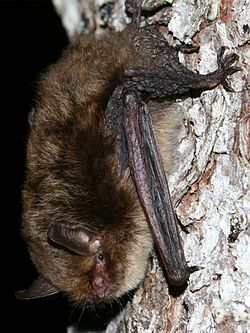 | M. alcathoe
von Helversen & Heller, 2001 | Europe and Turkey
 | Size: 3–5 cm (1–2 in), plus 3–4 cm (1–2 in) tail
3–4 cm (1–2 in) forearm length [7]
Habitat: Forest [8] | DD
Unknown  [8] [8]
|
|---|
| Anjouan myotis
| M. anjouanensis
Dorst, 1960 | Madagascar
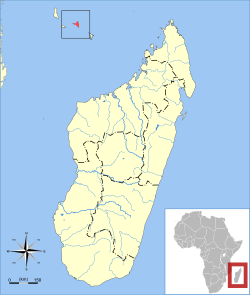 | Size: About 5 cm (2 in), plus about 5 cm (2 in) tail
about 4 cm (2 in) forearm length [7]
Habitat: Unknown [9] | DD
Unknown  [9] [9]
|
|---|
| Anna Tess's bat
| M. annatessae
Kruskop & Borisenko, 2013 | Vietnam and Laos
 | Size: 3–5 cm (1–2 in), plus 3–4 cm (1–2 in) tail
3–4 cm (1–2 in) forearm length [10]
Habitat: Forest [11] | DD
Unknown  [11] [11]
|
|---|
| Annamit myotis
| M. annamiticus
Kruskop & Tsytsulina, 2001 | Vietnam
 | Size: About 4 cm (2 in), plus about 3 cm (1 in) tail
about 4 cm (2 in) forearm length [10]
Habitat: Forest and inland wetlands [12] | DD
Unknown  [12] [12]
|
|---|
| Arizona myotis
| M. occultus
Hollister, 1909 | Mexico and southwestern United States
 | Size: 4–6 cm (2–2 in), plus 2–5 cm (1–2 in) tail
3–5 cm (1–2 in) forearm length [5]
Habitat: Forest, rocky areas, caves, and desert [13] | LC
Unknown  [13] [13]
|
|---|
| Atacama myotis
| M. atacamensis
Lataste, 1892 | Chile and Peru
 | Size: 4–5 cm (2–2 in), plus 3–4 cm (1–2 in) tail
3–4 cm (1–2 in) forearm length [14]
Habitat: Shrubland, rocky areas, and desert [15] | EN
Unknown  [15] [15]
|
|---|
| Australian myotis
| M. australis
Dobson, 1878 | Australia
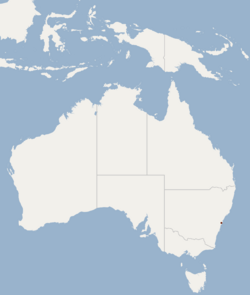 | Size: Unknown [16]
Habitat: Unknown [16] | DD
Unknown  [16] [16]
|
|---|
| Barbados myotis
| M. nyctor
LaVal & Schwartz, 1974 | Lesser Antilles in the Caribbean | Size: 4–5 cm (2–2 in), plus 3–4 cm (1–2 in) tail
3–4 cm (1–2 in) forearm length [14]
Habitat: Forest and caves [17] | VU
Unknown  [17] [17]
|
|---|
| Bechstein's bat 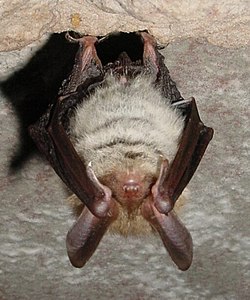 | M. bechsteinii
(Kuhl, 1817) | Europe and western Asia
 | Size: 3–6 cm (1–2 in), plus 3–5 cm (1–2 in) tail
3–5 cm (1–2 in) forearm length [18]
Habitat: Forest, shrubland, and caves [19] | NT
Unknown  [19] [19]
|
|---|
| Beijing mouse-eared bat
| M. pequinius
Thomas, 1908 | Eastern China
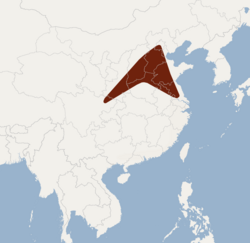 | Size: About 6 cm (2 in), plus about 4 cm (2 in) tail
4–6 cm (2–2 in) forearm length [18]
Habitat: Forest and caves [20] | LC
Unknown  [20] [20]
|
|---|
| Black myotis  | M. nigricans
Schinz, 1821
- M. n. carteri
- M. n. extremus
- M. n. nigricans
- M. n. osculatii
| Mexico, Central America, and South America
 | Size: 3–6 cm (1–2 in), plus 2–4 cm (1–2 in) tail
3–4 cm (1–2 in) forearm length [7]
Habitat: Forest, savanna, shrubland, and caves [21] | LC
Unknown  [21] [21]
|
|---|
| Bocharic myotis
| M. bucharensis
Kuzyakin, 1950 | Central Asia
 | Size: 4–6 cm (2–2 in), plus 4–6 cm (2–2 in) tail
3–5 cm (1–2 in) forearm length [18]
Habitat: Caves [22] | DD
Unknown  [22] [22]
|
|---|
| Bornean whiskered myotis
| M. borneoensis
Hill & Francis, 1984 | Island of Borneo (in green)
 | Size: Unknown length, plus 4–5 cm (2–2 in) tail
4–5 cm (2–2 in) forearm length [10]
Habitat: Forest [23] | DD
Unknown  [23] [23]
|
|---|
| Brandt's bat 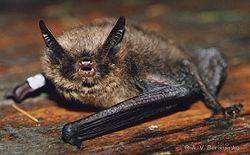 | M. brandtii
(Eversmann, 1845)
- M. b. brandtii
- M. b. gracilis
| Europe and western Asia (in red)
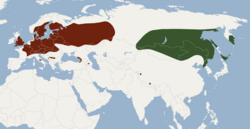 | Size: 3–5 cm (1–2 in), plus 3–5 cm (1–2 in) tail
3–4 cm (1–2 in) forearm length [7]
Habitat: Forest, shrubland, grassland, inland wetlands, and caves [24] | LC
Unknown  [24] [24]
|
|---|
| Burmese whiskered myotis  | M. montivagus
(Dobson, 1874) | Southern Asia (in leftmost red)
 | Size: Unknown length
3–5 cm (1–2 in) forearm length [10]
Habitat: Forest and caves [25] | DD
Unknown  [25] [25]
|
|---|
| California myotis  | M. californicus
(Audubon & Bachman, 1842)
- M. c. californicus
- M. c. caurinus
- M. c. mexicanus
- M. c. stephensi
| Western North America
 | Size: 3–5 cm (1–2 in), plus 3–5 cm (1–2 in) tail
3–4 cm (1–2 in) forearm length [5]
Habitat: Forest, caves, and desert [26] | LC
Unknown  [26] [26]
|
|---|
| Cape hairy bat
| M. tricolor
(Temminck, 1832) | Sub-Saharan Africa
 | Size: 5–7 cm (2–3 in), plus 3–6 cm (1–2 in) tail
4–6 cm (2–2 in) forearm length [7]
Habitat: Forest, savanna, and shrubland [27] | LC
Unknown  [27] [27]
|
|---|
| Cave myotis  | M. velifer
(Allen, 1890)
- M. v. brevis
- M. v. grandis
- M. v. incautus
- M. v. magnamolaris
- M. v. velifer
| United States and Mexico
 | Size: 4–6 cm (2–2 in), plus 3–6 cm (1–2 in) tail
3–5 cm (1–2 in) forearm length [14]
Habitat: Forest and caves [28] | LC
Unknown  [28] [28]
|
|---|
| Chilean myotis  | M. chiloensis
(Waterhouse, 1840) | Southern South America
 | Size: 4–5 cm (2–2 in), plus 2–4 cm (1–2 in) tail
3–5 cm (1–2 in) forearm length [14]
Habitat: Rocky areas and forest [29] | LC
Unknown  [29] [29]
|
|---|
| Chinese water myotis
| M. laniger
Peters, 1870 | Eastern Asia
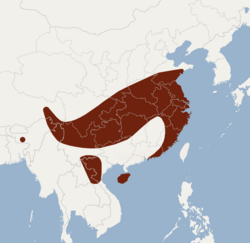 | Size: 3–5 cm (1–2 in), plus 3–4 cm (1–2 in) tail
3–4 cm (1–2 in) forearm length [10]
Habitat: Forest and caves [30] | LC
Unknown  [30] [30]
|
|---|
| Cinnamon myotis
| M. fortidens
Miller & Allen, 1928
- M. f. fortidens
- M. f. sonoriensis
| Guatemala and Mexico
 | Size: 4–6 cm (2–2 in), plus 3–4 cm (1–2 in) tail
3–4 cm (1–2 in) forearm length [5]
Habitat: Forest and caves [31] | LC
Unknown  [31] [31]
|
|---|
| Cryptic myotis  | M. crypticus
Ruedi, Ibáñez, Salicini, Juste, & Puechmaille, 2019 | Southern Europe | Size: 4–5 cm (2–2 in), plus 3–5 cm (1–2 in) tail
3–5 cm (1–2 in) forearm length [18]
Habitat: Forest, inland wetlands, and caves [32] | NT
Unknown  [32] [32]
|
|---|
| Csorba's mouse-eared bat
| M. csorbai
Topál, 1997 | Nepal | Size: Unknown [33]
Habitat: Forest [33] | DD
Unknown  [33] [33]
|
|---|
| Curacao myotis
| M. nesopolus
Miller, 1900
- M. n. larensis
- M. n. nesopolus
| Northern South America
 | Size: About 3 cm (1 in), plus about 4 cm (2 in) tail
2–4 cm (1–2 in) forearm length [14]
Habitat: Forest and shrubland [34] | LC
Unknown  [34] [34]
|
|---|
| Dark-nosed small-footed myotis
| M. melanorhinus
Merriam, 1890 | Western North America
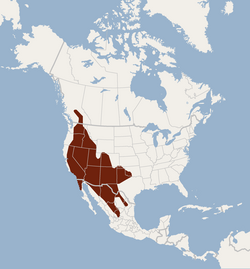 | Size: 3–5 cm (1–2 in), plus 2–5 cm (1–2 in) tail
3–4 cm (1–2 in) forearm length [5]
Habitat: Caves and forest | LC
Unknown 
|
|---|
| Daubenton's bat 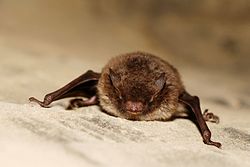 | M. daubentonii
(Kuhl, 1817)
- M. d. chasanensis
- M. d. daubentonii
- M. d. loukashkini
- M. d. nathalinae
- M. d. ussuriensis
- M. d. volgensis
| Europe and Asia
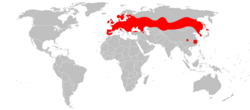 | Size: 4–6 cm (2–2 in), plus 2–5 cm (1–2 in) tail
3–5 cm (1–2 in) forearm length [18]
Habitat: Forest, shrubland, inland wetlands, rocky areas, caves, and neritic marine [36] | LC
Unknown  [36] [36]
|
|---|
| David's myotis
| M. davidii
Peters, 1869 | Eastern Asia
 | Size: 3–5 cm (1–2 in), plus 3–5 cm (1–2 in) tail
3–4 cm (1–2 in) forearm length [7]
Habitat: Caves and forest [37] | LC
Unknown  [37] [37]
|
|---|
| Diminutive bat
| M. diminutus
Moratelli & Wilson, 2011 | Ecuador and Colombia | Size: About 4 cm (2 in), plus about 3 cm (1 in) tail
about 3 cm (1 in) forearm length [14]
Habitat: Forest [38] | DD
Unknown  [38] [38]
|
|---|
| Dinelli's myotis  | M. dinellii
Thomas, 1902 | Southern South America (in green)
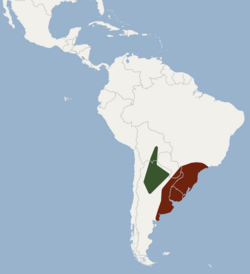 | Size: 4–6 cm (2–2 in), plus 2–5 cm (1–2 in) tail
3–4 cm (1–2 in) forearm length [14]
Habitat: Forest [39] | LC
Unknown  [39] [39]
|
|---|
| Dominican myotis
| M. dominicensis
Miller, 1902 | Dominica and Guadeloupe in the Caribbean
 | Size: 4–5 cm (2–2 in), plus 2–4 cm (1–2 in) tail
3–4 cm (1–2 in) forearm length [14]
Habitat: Inland wetlands and caves [40] | VU
Unknown  [40] [40]
|
|---|
| Eastern long-fingered bat 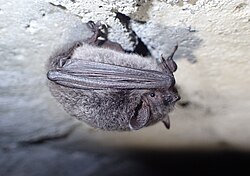 | M. macrodactylus
(Temminck, 1840)
- M. m. continentalis
- M. m. insularis
- M. m. macrodactylus
| Eastern Asia
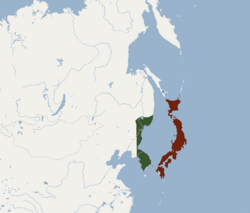 | Size: 4–8 cm (2–3 in), plus 2–5 cm (1–2 in) tail
3–5 cm (1–2 in) forearm length [18]
Habitat: Forest, inland wetlands, and caves [41] | LC
Unknown  [41] [41]
|
|---|
| Eastern small-footed myotis | M. leibii
Audubon & Bachman, 1842 | Eastern United States and Canada
 | Size: 4–5 cm (2–2 in), plus 3–5 cm (1–2 in) tail
3–4 cm (1–2 in) forearm length [5]
Habitat: Caves, rocky areas, and forest | EN
Unknown 
|
|---|
| Eastern water bat  | M. petax
Hollister, 1912 | Eastern Asia
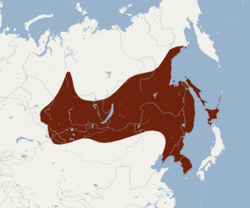 | Size: 4–6 cm (2–2 in), plus 2–5 cm (1–2 in) tail
3–4 cm (1–2 in) forearm length [18]
Habitat: Caves, inland wetlands, and forest [43] | LC
Unknown  [43] [43]
|
|---|
| Elegant myotis
| M. elegans
Hall, 1962 | Mexico and Central America
 | Size: 3–5 cm (1–2 in), plus 3–4 cm (1–2 in) tail
3–4 cm (1–2 in) forearm length [14]
Habitat: Forest [44] | LC
Unknown  [44] [44]
|
|---|
| Escalera's bat  | M. escalerai
A. Cabrera, 1904 | Southwestern Europe | Size: 4–5 cm (2–2 in), plus 4–5 cm (2–2 in) tail
3–5 cm (1–2 in) forearm length [18]
Habitat: Forest, shrubland, and caves [45] | NT
Unknown  [45] [45]
|
|---|
| Far Eastern myotis
| M. bombinus
Thomas, 1906
- M. b. amurensis
- M. b. bombinus
| Eastern Asia
 | Size: 4–6 cm (2–2 in), plus 3–5 cm (1–2 in) tail
3–5 cm (1–2 in) forearm length [18]
Habitat: Forest and caves [46] | NT
Unknown  [46] [46]
|
|---|
| Felten's myotis  | M. punicus
Felten, 1977 | Northern Africa and Mediterranean islands
 | Size: 6–8 cm (2–3 in), plus tail
5–7 cm (2–3 in) forearm length [18]
Habitat: Caves, grassland, shrubland, and forest [47] | DD
Unknown  [47] [47]
|
|---|
| Fish-eating bat  | M. vivesi
Ménégaux, 1901 | Western Mexico
 | Size: 8–9 cm (3–4 in), plus 5–8 cm (2–3 in) tail
5–7 cm (2–3 in) forearm length [14]
Habitat: Rocky areas and caves [48] | VU
Unknown  [48] [48]
|
|---|
| Findley's myotis
| M. findleyi
Bogan, 1978 | Tres Marías Islands west of Mexico
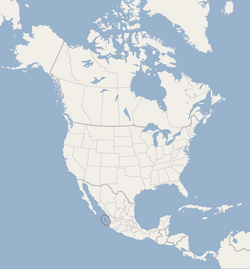 | Size: 4–5 cm (2–2 in), plus 2–4 cm (1–2 in) tail
2–4 cm (1–2 in) forearm length [5]
Habitat: Unknown [49] | EN
Unknown  [49] [49]
|
|---|
| Flat-headed myotis  | M. planiceps
Baker, 1955 | Central Mexico
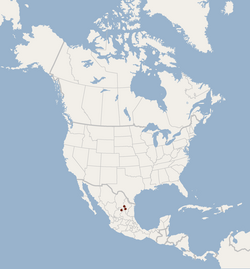 | Size: 3–6 cm (1–2 in), plus 2–3 cm (1–1 in) tail
2–3 cm (1–1 in) forearm length [5]
Habitat: Forest and caves [50] | EN
240  [50] [50]
|
|---|
| Fraternal myotis  | M. frater
(Allen, 1923) | Eastern Asia (in red)
 | Size: 3–5 cm (1–2 in), plus 4–6 cm (2–2 in) tail
3–5 cm (1–2 in) forearm length [18]
Habitat: Forest and caves [51] | LC
Unknown  [51] [51]
|
|---|
| Fringed long-footed myotis
| M. fimbriatus
Peters, 1870 | Eastern Asia
 | Size: 3–6 cm (1–2 in), plus 3–5 cm (1–2 in) tail
3–5 cm (1–2 in) forearm length [18]
Habitat: Caves | LC
Unknown 
|
|---|
| Fringed myotis  | M. thysanodes
Miller, 1897
- M. t. aztecus
- M. t. pahasapensis
- M. t. thysanodes
- M. t. vespertinus
| Western North America
 | Size: 4–6 cm (2–2 in), plus 3–5 cm (1–2 in) tail
4–5 cm (2–2 in) forearm length [5]
Habitat: Forest, rocky areas, caves, and desert [53] | LC
Unknown  [53] [53]
|
|---|
| Frosted myotis
| M. pruinosus
Yoshiyuki, 1971 | Japan
 | Size: 3–5 cm (1–2 in), plus 3–4 cm (1–2 in) tail
3–4 cm (1–2 in) forearm length [10]
Habitat: Forest and caves [54] | EN
Unknown  [54] [54]
|
|---|
| Geoffroy's bat 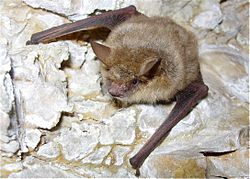 | M. emarginatus
(Geoffroy, 1806)
- M. e. desertorum
- M. e. emarginatus
- M. e. turcomanicus
| Europe, northern Africa, and western Asia
 | Size: 4–6 cm (2–2 in), plus 3–5 cm (1–2 in) tail
3–5 cm (1–2 in) forearm length [7]
Habitat: Caves, grassland, and shrubland [55] | LC
Unknown  [55] [55]
|
|---|
| Gomantong myotis
| M. gomantongensis
Francis & Hill, 1998 | Island of Borneo in Malaysia
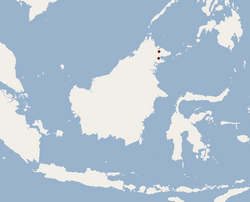 | Size: Unknown length, plus 3–5 cm (1–2 in) tail
4–5 cm (2–2 in) forearm length [10]
Habitat: Caves [56] | LC
Unknown  [56] [56]
|
|---|
| Gray bat  | M. grisescens
Howell, 1909 | Eastern United States
 | Size: 4–6 cm (2–2 in), plus 3–5 cm (1–2 in) tail
4–5 cm (2–2 in) forearm length [14]
Habitat: Forest and caves [57] | VU
Unknown  [57] [57]
|
|---|
| Greater mouse-eared bat 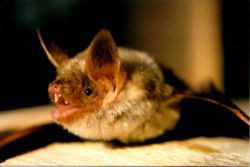 | M. myotis
(Borkhausen, 1797)
- M. m. macrocephalicus
- M. m. myotis
| Europe and western Asia
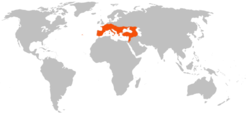 | Size: 6–9 cm (2–4 in), plus 4–6 cm (2–2 in) tail
5–7 cm (2–3 in) forearm length [18]
Habitat: Forest, shrubland, and caves [58] | LC
Unknown  [58] [58]
|
|---|
| Guatemalan myotis
| M. cobanensis
Goodwin, 1955 | Guatemala
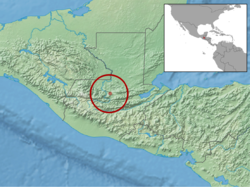 | Size: About 4 cm (2 in), plus about 4 cm (2 in) tail
about 4 cm (2 in) forearm length [14]
Habitat: Unknown [59] | DD
Unknown  [59] [59]
|
|---|
| Hairy-faced bat
| M. annectans
Dobson, 1871 | Southern and southeastern Asia
 | Size: 5–7 cm (2–3 in), plus 4–5 cm (2–2 in) tail
4–5 cm (2–2 in) forearm length [10]
Habitat: Forest [60] | LC
Unknown  [60] [60]
|
|---|
| Hairy-legged myotis  | M. keaysi
Allen, 1914
- M. k. keaysi
- M. k. pilosotibialis
| Mexico, Central America, and northern and western South America
 | Size: 5–7 cm (2–3 in), plus 2–5 cm (1–2 in) tail
Unknown forearm length [5]
Habitat: Forest [61] | LC
Unknown  [61] [61]
|
|---|
| Herman's myotis
| M. hermani
Thomas, 1923 | Indonesia
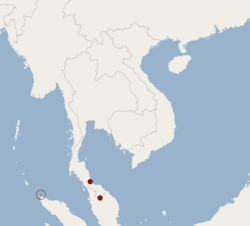 | Size: 5–6 cm (2–2 in), plus 3–6 cm (1–2 in) tail
4–6 cm (2–2 in) forearm length [7]
Habitat: Forest [62] | DD
Unknown  [62] [62]
|
|---|
| Himalayan whiskered bat
| M. siligorensis
Horsfield, 1855
- M. s. alticraniatus
- M. s. siligorensis
- M. s. sowerbyi
- M. s. thaianus
| Central, eastern, and southeastern Asia
 | Size: Unknown length
about 3 cm (1 in) forearm length [10]
Habitat: Forest and caves [63] | LC
Unknown  [63] [63]
|
|---|
| Hodgson's bat  | M. formosus
(Hodgson, 1835) | Central and eastern, and southeastern Asia | Size: 5–6 cm (2–2 in), plus 3–6 cm (1–2 in) tail
4–6 cm (2–2 in) forearm length [7]
Habitat: Forest, shrubland, grassland, and caves [64] | NT
Unknown  [64] [64]
|
|---|
| Horsfield's bat  | M. horsfieldii
Temminck, 1840
- M. h. deignani
- M. h. dryas
- M. h. horsfieldii
- M. h. jeannei
- M. h. peshwa
| Southern and southeastern Asia
 | Size: 4–6 cm (2–2 in), plus 3–5 cm (1–2 in) tail
3–5 cm (1–2 in) forearm length [10]
Habitat: Forest and caves [65] | LC
Unknown  [65] [65]
|
|---|
| Ikonnikov's bat
| M. ikonnikovi
Ogniov, 1912 | Eastern Asia
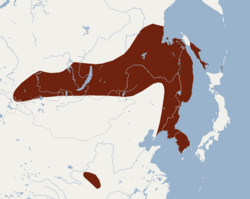 | Size: 3–6 cm (1–2 in), plus 2–5 cm (1–2 in) tail
3–4 cm (1–2 in) forearm length [7]
Habitat: Forest, inland wetlands, and caves [66] | LC
Unknown  [66] [66]
|
|---|
| Indiana bat  | M. sodalis
Miller, 1898 | Eastern United States
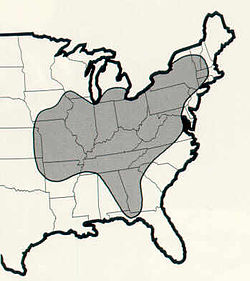 | Size: 4–5 cm (2–2 in), plus 2–5 cm (1–2 in) tail
3–4 cm (1–2 in) forearm length [5]
Habitat: Forest and caves [67] | NT
Unknown  [67] [67]
|
|---|
| Indochinese mouse-eared bat
| M. indochinensis
Son, Motokawa, Estók, Thong, Dang, Oshida, Csorba, Francis, Görföl, & Endō, 2013 | Vietnam and China
 | Size: Unknown length
4–5 cm (2–2 in) forearm length [10]
Habitat: Forest [68] | DD
Unknown  [68] [68]
|
|---|
| Insular myotis
| M. insularum
Dobson, 1878 | American Samoa | Size: About 4 cm (2 in), plus about 4 cm (2 in) tail
about 4 cm (2 in) forearm length [10]
Habitat: Unknown [69] | DD
Unknown  [69] [69]
|
|---|
| Izecksohn's myotis
| M. izecksohni
Moratelli, Peracchi, Dias, & de Oliveira, 2011 | Brazil and Argentina
 | Size: 4–7 cm (2–3 in), plus 3–5 cm (1–2 in) tail
3–4 cm (1–2 in) forearm length [14]
Habitat: Forest [70] | DD
Unknown  [70] [70]
|
|---|
| Kashmir cave bat
| M. longipes
Dobson, 1873 | Southern Asia | Size: 3–5 cm (1–2 in), plus 3–5 cm (1–2 in) tail
3–4 cm (1–2 in) forearm length [10]
Habitat: Forest and caves [71] | DD
Unknown  [71] [71]
|
|---|
| Keen's myotis  | M. keenii
(Merriam, 1895) | Western Canada and United States
 | Size: 4–6 cm (2–2 in), plus 3–5 cm (1–2 in) tail
3–4 cm (1–2 in) forearm length [5]
Habitat: Forest and rocky areas [72] | LC
Unknown  [72] [72]
|
|---|
| Kei myotis
| M. stalkeri
Thomas, 1910 | Indonesia
 | Size: 4–8 cm (2–3 in), plus 5–6 cm (2–2 in) tail
5–6 cm (2–2 in) forearm length [10]
Habitat: Forest, inland wetlands, and caves [73] | LC
10,000–11,000  [73] [73]
|
|---|
| Kock's mouse-eared bat
| M. dieteri
Happold, 2005 | Republic of the Congo | Size: About 5 cm (2 in), plus about 4 cm (2 in) tail
about 4 cm (2 in) forearm length [7]
Habitat: Forest and caves [74] | DD
Unknown  [74] [74]
|
|---|
| Large myotis
| M. chinensis
Tomes, 1857 | Eastern and southeastern Asia
 | Size: 9–10 cm (4–4 in), plus 5–6 cm (2–2 in) tail
6–7 cm (2–3 in) forearm length [18]
Habitat: Forest, inland wetlands, and caves [75] | LC
Unknown  [75] [75]
|
|---|
| Large-footed bat  | M. adversus
Horsfield, 1824
- M. a. adversus
- M. a. carimatae
- M. a. orientis
- M. a. taiwanensis
- M. a. tanimbarensis
- M. a. wetarensis
| Southeastern Asia
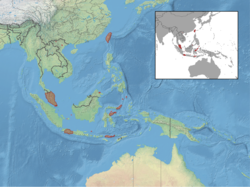 | Size: 4–6 cm (2–2 in), plus 3–5 cm (1–2 in) tail
3–5 cm (1–2 in) forearm length [10]
Habitat: Forest, inland wetlands, and caves | LC
Unknown 
|
|---|
| Large-footed myotis  | M. macropus
(Gould, 1854) | Eastern Australia | Size: 3–5 cm (1–2 in), plus 3–5 cm (1–2 in) tail
3–5 cm (1–2 in) forearm length [18]
Habitat: Inland wetlands and caves [77] | LC
Unknown  [77] [77]
|
|---|
| LaVal's myotis
| M. lavali
Moratelli, Peracchi, Dias, & de Oliveira, 2011 | Central and eastern South America
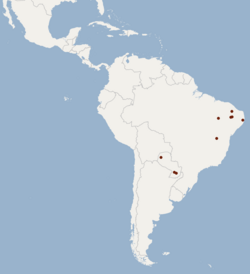 | Size: 4–5 cm (2–2 in), plus 3–5 cm (1–2 in) tail
3–4 cm (1–2 in) forearm length [14]
Habitat: Forest, savanna, and grassland [78] | LC
Unknown  [78] [78]
|
|---|
| Lesser large-footed bat
| M. hasseltii
Temminck, 1840
- M. h. abboti
- M. h. continentis
- M. h. hasseltii
- M. h. macellus
| Southern and southeastern Asia
 | Size: 4–6 cm (2–2 in), plus 3–5 cm (1–2 in) tail
3–5 cm (1–2 in) forearm length [18]
Habitat: Forest and caves | LC
Unknown 
|
|---|
| Lesser mouse-eared bat  | M. blythii
Tomes, 1857
- M. b. ancilla
- M. b. blythii
- M. b. lesviacus
- M. b. omari
| Europe and Asia
 | Size: 5–8 cm (2–3 in), plus about 6 cm (2 in) tail
5–7 cm (2–3 in) forearm length [18]
Habitat: Shrubland, grassland, and caves [80] | LC
Unknown  [80] [80]
|
|---|
| Little brown bat  | M. lucifugus
(Conte, 1831)
- M. l. alascensis
- M. l. carissima
- M. l. lucifugus
- M. l. pernox
- M. l. relictus
| United States and Canada
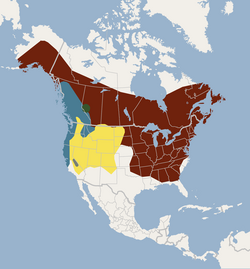 | Size: 3–6 cm (1–2 in), plus 2–5 cm (1–2 in) tail
3–5 cm (1–2 in) forearm length [5]
Habitat: Forest and caves [81] | EN
Unknown  [81] [81]
|
|---|
| Long-eared myotis  | M. evotis
(H. Allen, 1864)
- M. e. chrysonotus
- M. e. evotis
- M. e. jonesorum
- M. e. micronyx
- M. e. milleri
- M. e. pacificus
| Western North America
 | Size: 4–6 cm (2–2 in), plus 3–5 cm (1–2 in) tail
3–4 cm (1–2 in) forearm length [5]
Habitat: Caves, rocky areas, and forest [82] | LC
Unknown  [82] [82]
|
|---|
| Long-fingered bat 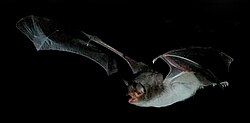 | M. capaccinii
Bonaparte, 1837 | Southern Europe, northern Africa, and western Asia
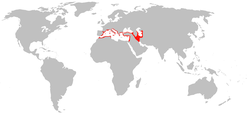 | Size: 4–6 cm (2–2 in), plus 3–5 cm (1–2 in) tail
3–5 cm (1–2 in) forearm length [10]
Habitat: Shrubland, inland wetlands, and caves [83] | VU
Unknown  [83] [83]
|
|---|
| Long-legged myotis  | M. volans
H. Allen, 1866
- M. v. amotus
- M. v. interior
- M. v. longicrus
- M. v. volans
| Western North America
 | Size: 4–7 cm (2–3 in), plus 4–5 cm (2–2 in) tail
3–5 cm (1–2 in) forearm length [5]
Habitat: Forest, rocky areas, caves, and desert [84] | LC
Unknown  [84] [84]
|
|---|
| Long-tailed myotis
| M. longicaudatus
Ogniov, 1927
- M. l. eniseensis
- M. l. kaguyae
- M. l. longicaudatus
| Eastern Asia (excluding red)
 | Size: 4–6 cm (2–2 in), plus 3–5 cm (1–2 in) tail
3–5 cm (1–2 in) forearm length [18]
Habitat: Forest, inland wetlands, and caves [85] | LC
Unknown  [85] [85]
|
|---|
| Long-toed myotis  | M. secundus
Ruedi, Csorba, Lin, & Chou, 2015 | Taiwan | Size: 3–5 cm (1–2 in), plus 3–5 cm (1–2 in) tail
3–4 cm (1–2 in) forearm length [10]
Habitat: Forest [86] | LC
Unknown  [86] [86]
|
|---|
| Malagasy mouse-eared bat
| M. goudoti
Smith, 1834 | Madagascar
 | Size: Unknown length
3–4 cm (1–2 in) forearm length [7]
Habitat: Forest, rocky areas, and caves [87] | LC
Unknown  [87] [87]
|
|---|
| Malaysian whiskered myotis
| M. federatus
Thomas, 1916 | Malaysia (in blue)
 | Size: About 5 cm (2 in), plus about 4 cm (2 in) tail
3–5 cm (1–2 in) forearm length [10]
Habitat: Forest [88] | DD
Unknown  [88] [88]
|
|---|
| Maluku myotis
| M. moluccarum
Thomas, 1915
- M. m. moluccarum
- M. m. richardsi
- M. m. solomonis
| Indonesia
 | Size: 4–6 cm (2–2 in), plus 2–5 cm (1–2 in) tail
3–5 cm (1–2 in) forearm length [10]
Habitat: Forest and inland wetlands [89] | LC
Unknown  [89] [89]
|
|---|
| Mandelli's mouse-eared bat
| M. sicarius
Thomas, 1915 | India and Nepal | Size: 5–6 cm (2–2 in), plus 4–6 cm (2–2 in) tail
4–6 cm (2–2 in) forearm length [18]
Habitat: Forest and caves [90] | VU
Unknown  [90] [90]
|
|---|
| Montane myotis
| M. oxyotus
Peters, 1867
- M. o. gardneri
- M. o. oxyotus
| Northern and western South America
 | Size: 4–6 cm (2–2 in), plus 4–5 cm (2–2 in) tail
3–5 cm (1–2 in) forearm length [14]
Habitat: Forest [91] | LC
Unknown  [91] [91]
|
|---|
| Morris's bat
| M. morrisi
Hill, 1971 | Ethiopia and Nigeria
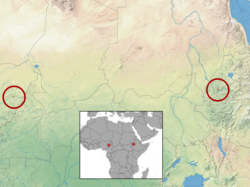 | Size: About 5 cm (2 in), plus about 5 cm (2 in) tail
4–5 cm (2–2 in) forearm length [7]
Habitat: Savanna and caves [92] | DD
Unknown  [92] [92]
|
|---|
| Natterer's bat  | M. nattereri
(Kuhl, 1817)
- M. n. nattereri
- M. n. tschuliensis
| Europe and western Asia | Size: 4–5 cm (2–2 in), plus 3–5 cm (1–2 in) tail
3–5 cm (1–2 in) forearm length [18]
Habitat: Forest, shrubland, grassland, inland wetlands, and caves [93] | LC
Unknown  [93] [93]
|
|---|
| Nepal myotis
| M. nipalensis
Dobson, 1871
- M. n. nipalensis
- M. n. przewalskii
- M. n. transcaspicus
| Central and western Asia
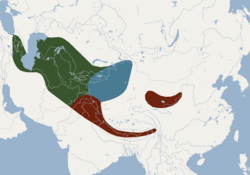 | Size: About 4 cm (2 in), plus about 33–5 cm (1–2 in) tail
about 3 cm (1 in) forearm length [7]
Habitat: Forest, shrubland, grassland, caves, and desert [94] | LC
Unknown  [94] [94]
|
|---|
| Nimba myotis
| M. nimbaensis
Simmons, Flanders, Fils, Parker, Suter, Bamba, Douno, Keita, Morales, & Frick, 2021 | Guinea | Size: 6–8 cm (2–3 in), plus 4–5 cm (2–2 in) tail
5–6 cm (2–2 in) forearm length [7]
Habitat: Forest, grassland, inland wetlands, caves, and shrubland [95] | CR
Unknown  [95] [95]
|
|---|
| Northern long-eared bat  | M. septentrionalis
Trouessart, 1897 | Canada and eastern United States
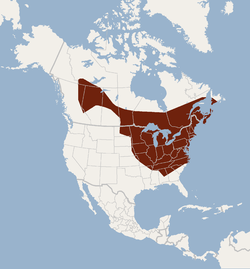 | Size: 4–5 cm (2–2 in), plus 3–5 cm (1–2 in) tail
3–4 cm (1–2 in) forearm length [5]
Habitat: Forest and caves [96] | NT
Unknown  [96] [96]
|
|---|
| Orange-fingered myotis
| M. rufopictus
(Waterhouse, 1845) | Indonesia
 | Size: About 6 cm (2 in), plus 4–6 cm (2–2 in) tail
4–6 cm (2–2 in) forearm length [7]
Habitat: Forest [97] | DD
Unknown  [97] [97]
|
|---|
| Pallid large-footed myotis
| M. macrotarsus
Waterhouse, 1845
- M. m. macrotarsus
- M. m. saba
| Indonesia
 | Size: About 6 cm (2 in), plus 4–6 cm (2–2 in) tail
4–5 cm (2–2 in) forearm length [10]
Habitat: Caves | LC
Unknown 
|
|---|
| Peninsular myotis  | M. peninsularis
Miller, 1898 | Southern Baja California peninsula
 | Size: 4–6 cm (2–2 in), plus 3–6 cm (1–2 in) tail
3–5 cm (1–2 in) forearm length [14]
Habitat: Forest and caves [99] | EN
Unknown  [99] [99]
|
|---|
| Peters's myotis
| M. ater
(Peters, 1866)
| Southeastern Asia
 | Size: 4–6 cm (2–2 in), plus 3–5 cm (1–2 in) tail
3–5 cm (1–2 in) forearm length [10]
Habitat: Forest | LC
Unknown 
|
|---|
| Peyton's myotis
| M. peytoni
Wroughton & Ryley, 1913 | Southern India (in yellow)
 | Size: 5–7 cm (2–3 in), plus 4–5 cm (2–2 in) tail
4–5 cm (2–2 in) forearm length [10]
Habitat: Forest [101] | DD
Unknown  [101] [101]
|
|---|
| Pond bat 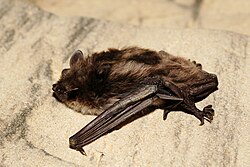 | M. dasycneme
(Boie, 1825) | Europe and northern Asia
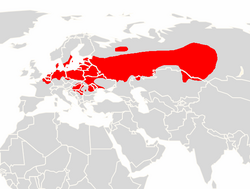 | Size: 5–7 cm (2–3 in), plus 4–6 cm (2–2 in) tail
4–5 cm (2–2 in) forearm length [7]
Habitat: Forest, inland wetlands, and caves [102] | NT
Unknown  [102] [102]
|
|---|
| Red myotis 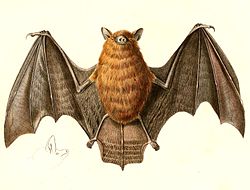 | M. ruber
Geoffroy, 1806 | Southeastern South America
 | Size: 4–5 cm (2–2 in), plus 3–5 cm (1–2 in) tail
3–5 cm (1–2 in) forearm length [5]
Habitat: Forest [103] | NT
Unknown  [103] [103]
|
|---|
| Reddish myotis
| M. soror
Ruedi, Csorba, Lin, & Chou, 2015 | Taiwan | Size: About 5 cm (2 in), plus about 4 cm (2 in) tail
about 4 cm (2 in) forearm length [18]
Habitat: Forest [104] | DD
Unknown  [104] [104]
|
|---|
| Reddish-black myotis  | M. rufoniger
(Tomes, 1858) | Eastern Asia
 | Size: 5–8 cm (2–3 in), plus 4–6 cm (2–2 in) tail
4–6 cm (2–2 in) forearm length [7]
Habitat: Forest and caves [105] | LC
Unknown  [105] [105]
|
|---|
| Rickett's big-footed bat
| M. pilosus
Peters, 1869 | Eastern Asia
 | Size: 5–7 cm (2–3 in), plus 3–6 cm (1–2 in) tail
5–7 cm (2–3 in) forearm length [18]
Habitat: Forest and inland wetlands | VU
Unknown 
|
|---|
| Ridley's bat
| M. ridleyi
Thomas, 1898 | Southeastern Asia
 | Size: 3–5 cm (1–2 in), plus 2–4 cm (1–2 in) tail
2–4 cm (1–2 in) forearm length [10]
Habitat: Caves, inland wetlands, and forest [107] | NT
Unknown  [107] [107]
|
|---|
| Riparian myotis
| M. riparius
Handley, 1960 | Central America and South America
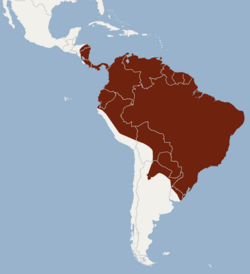 | Size: 4–5 cm (2–2 in), plus 2–5 cm (1–2 in) tail
3–4 cm (1–2 in) forearm length [14]
Habitat: Forest [108] | LC
Unknown  [108] [108]
|
|---|
| Rufous mouse-eared bat 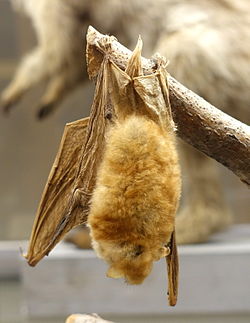 | M. bocagii
Peters, 1870
- M. b. bocagii
- M. b. cupreolus
- M. b. dogalensis
| Scattered sub-Saharan Africa and Yemen
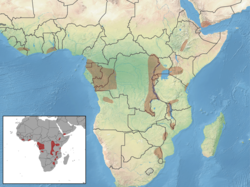 | Size: 5–6 cm (2–2 in), plus 3–5 cm (1–2 in) tail
3–5 cm (1–2 in) forearm length [7]
Habitat: Forest and savanna [109] | LC
Unknown  [109] [109]
|
|---|
| Schaub's myotis
| M. schaubi
Kormos, 1934
- M. s. araxenus
- M. s. schaubi
| Armenia and Iran | Size: 4–6 cm (2–2 in), plus 4–5 cm (2–2 in) tail
3–5 cm (1–2 in) forearm length [18]
Habitat: Forest, shrubland, and caves [110] | DD
Unknown  [110] [110]
|
|---|
| Schwartz's myotis
| M. martiniquensis
LaVal, 1973 | Barbados and Martinique in the Caribbean
 | Size: Unknown length
3–4 cm (1–2 in) forearm length [14]
Habitat: Caves [111] | NT
Unknown  [111] [111]
|
|---|
| Scott's mouse-eared bat
| M. scotti
Thomas, 1927 | Ethiopia | Size: 4–6 cm (2–2 in), plus 4–5 cm (2–2 in) tail
3–5 cm (1–2 in) forearm length [7]
Habitat: Forest and shrubland [112] | VU
Unknown  [112] [112]
|
|---|
| Siberian bat  | M. sibiricus
(Kastschenko, 1905) | Northeastern Asia (in green)
 | Size: 3–6 cm (1–2 in), plus 3–5 cm (1–2 in) tail
3–4 cm (1–2 in) forearm length [7]
Habitat: Forest, savanna, rocky areas, and caves [113] | LC
Unknown  [113] [113]
|
|---|
| Silver-tipped myotis  | M. albescens
Geoffroy, 1806 | Central America and South America
 | Size: 4–5 cm (2–2 in), plus 3–5 cm (1–2 in) tail
3–4 cm (1–2 in) forearm length [14]
Habitat: Forest [114] | LC
Unknown  [114] [114]
|
|---|
| Singapore whiskered bat
| M. oreias
(Temminck, 1840) | Singapore
 | Size: Unknown [115]
Habitat: Unknown [115] | DD
Unknown  [115] [115]
|
|---|
| Southeastern myotis 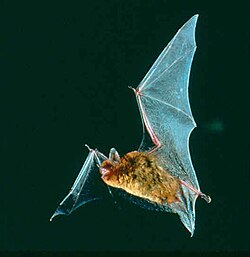 | M. austroriparius
(Rhoads, 1897) | Southeastern United States
 | Size: 4–6 cm (2–2 in), plus 2–5 cm (1–2 in) tail
3–4 cm (1–2 in) forearm length [14]
Habitat: Forest and caves [116] | LC
Unknown  [116] [116]
|
|---|
| Southern myotis
| M. aelleni
Baud, 1979 | Argentina
 | Size: 4–5 cm (2–2 in), plus 2–4 cm (1–2 in) tail
3–5 cm (1–2 in) forearm length [14]
Habitat: Unknown [117] | DD
Unknown  [117] [117]
|
|---|
| Southwestern myotis  | M. auriculus
Baker & Stains, 1955
- M. a. apache
- M. a. auriculus
| Southern United States and Mexico
 | Size: 5–6 cm (2–2 in), plus 3–5 cm (1–2 in) tail
3–4 cm (1–2 in) forearm length [5]
Habitat: Forest, caves, and desert [118] | LC
Unknown  [118] [118]
|
|---|
| Szechwan myotis
| M. altarium
Thomas, 1911 | China and Thailand
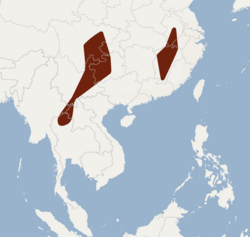 | Size: 4–6 cm (2–2 in), plus 3–5 cm (1–2 in) tail
4–5 cm (2–2 in) forearm length [7]
Habitat: Caves [119] | LC
Unknown  [119] [119]
|
|---|
| Thick-thumbed myotis
| M. rosseti
Oei, 1951 | Southeastern Asia
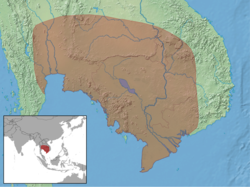 | Size: 3–5 cm (1–2 in), plus 3–5 cm (1–2 in) tail
2–4 cm (1–2 in) forearm length [10]
Habitat: Forest [120] | LC
Unknown  [120] [120]
|
|---|
| Velvety myotis
| M. simus
Thomas, 1901 | Western, central, and eastern South America
 | Size: 5–6 cm (2–2 in), plus 3–4 cm (1–2 in) tail
3–4 cm (1–2 in) forearm length [14]
Habitat: Forest [121] | DD
Unknown  [121] [121]
|
|---|
| Wall-roosting mouse-eared bat 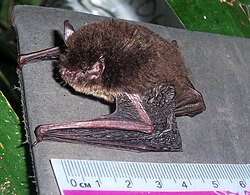 | M. muricola
(Gray, 1846)
- M. m. browni
- M. m. caliginosus
- M. m. herrei
- M. m. moupinensis
- M. m. muricola
- M. m. niasensis
- M. m. patriciae
| Southeastern Asia
 | Size: 4–6 cm (2–2 in), plus 3–5 cm (1–2 in) tail
3–4 cm (1–2 in) forearm length [10]
Habitat: Forest and caves [122] | LC
Unknown  [122] [122]
|
|---|
| Weber's myotis
| M. weberi
(Jentink, 1890) | Sulawesi island in Indonesia | Size: About 6 cm (2 in), plus about 4 cm (2 in) tail
4–6 cm (2–2 in) forearm length [7]
Habitat: Forest [123] | DD
Unknown  [123] [123]
|
|---|
| Welwitsch's bat  | M. welwitschii
(Gray, 1866) | Western, eastern, and southern Africa
 | Size: 5–7 cm (2–3 in), plus 5–7 cm (2–3 in) tail
5–6 cm (2–2 in) forearm length [7]
Habitat: Forest, savanna, shrubland, and grassland [124] | LC
Unknown  [124] [124]
|
|---|
| Western small-footed bat  | M. ciliolabrum
(Merriam, 1842) | Western North America
 | Size: 3–5 cm (1–2 in), plus 2–5 cm (1–2 in) tail
3–4 cm (1–2 in) forearm length [5]
Habitat: Forest, rocky areas, caves, and desert | LC
Unknown 
|
|---|
| Whiskered bat 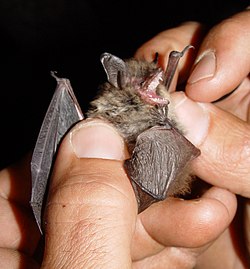 | M. mystacinus
(Kuhl, 1817)
- M. m. caucasicus
- M. m. mystacinus
- M. m. occidentalis
| Europe, northern Africa, and western Asia
 | Size: 3–5 cm (1–2 in), plus 3–5 cm (1–2 in) tail
3–4 cm (1–2 in) forearm length [7]
Habitat: Desert, caves, grassland, shrubland, and forest [126] | LC
Unknown  [126] [126]
|
|---|
| Yanbaru whiskered bat
| M. yanbarensis
Maeda & Matsumura, 1998 | Ryukyu Islands in Japan
 | Size: 3–5 cm (1–2 in), plus 3–5 cm (1–2 in) tail
3–4 cm (1–2 in) forearm length [10]
Habitat: Forest [127] | CR
Unknown  [127] [127]
|
|---|
| Yellowish myotis  | M. levis
Geoffroy, 1806 | Southeastern South America (in red)
 | Size: 3–6 cm (1–2 in), plus 4–5 cm (2–2 in) tail
3–5 cm (1–2 in) forearm length [14]
Habitat: Forest [128] | LC
Unknown  [128] [128]
|
|---|
| Yuma myotis  | M. yumanensis
H. Allen, 1864
- M. y. lambi
- M. y. lutosus
- M. y. oxalis
- M. y. saturatus
- M. y. sociabilis
- M. y. yumanensis
| Western North America
 | Size: 4–5 cm (2–2 in), plus 2–4 cm (1–2 in) tail
3–4 cm (1–2 in) forearm length [14]
Habitat: Forest and caves [129] | LC
Unknown  [129] [129]
|
|---|




















































































































































